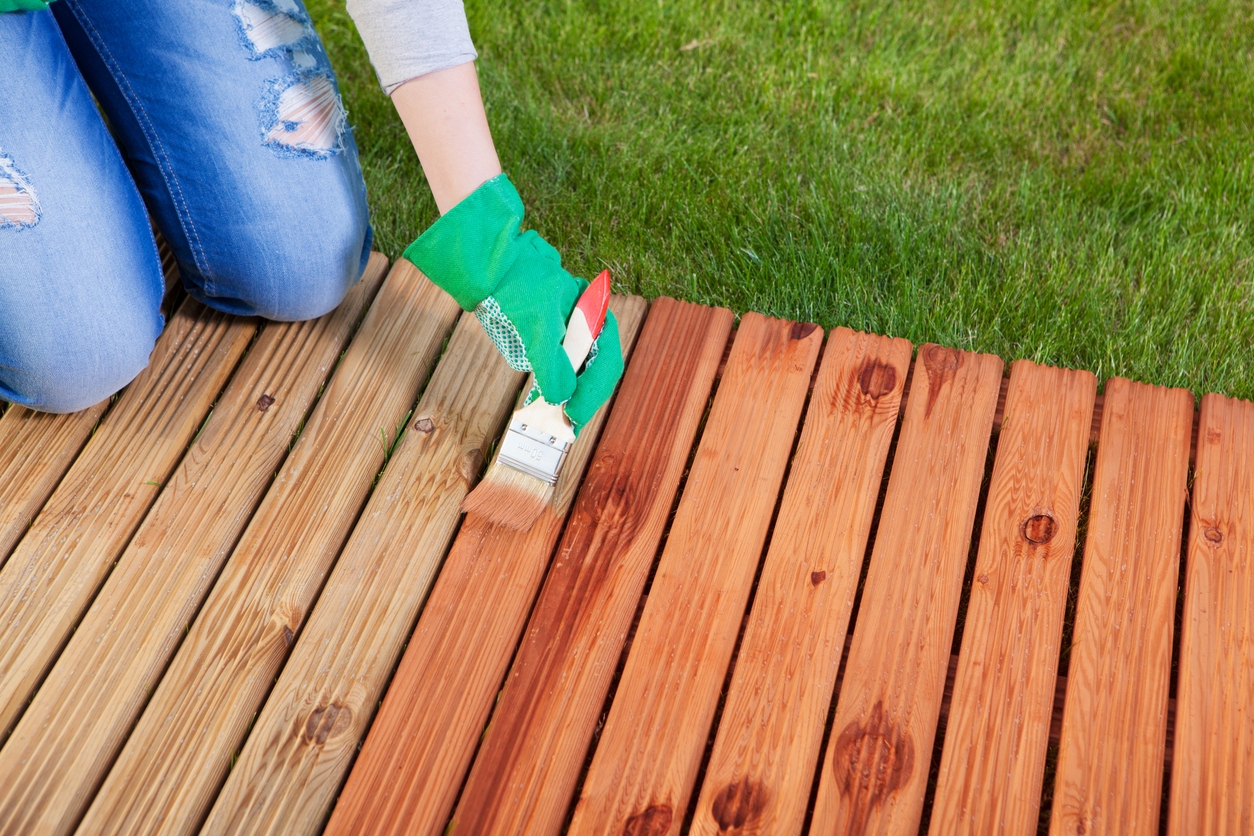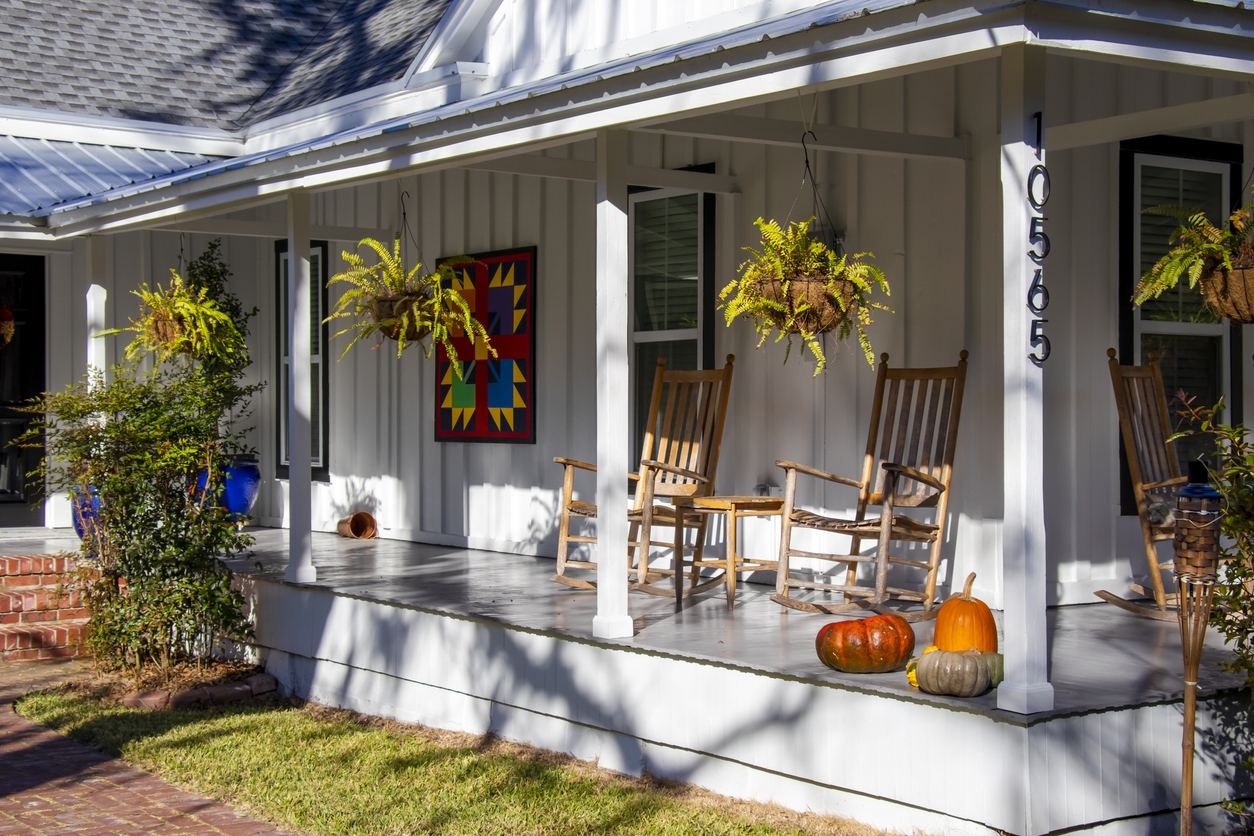A cohesive design in exterior home painting is crucial for creating a unified and visually appealing look for your Livermore home and ensuring that every element of your home’s exterior complements one another. The porch, often the first feature guests notice, is significant in enhancing your home’s overall aesthetic, serving as a welcoming focal point that ties the entire exterior design together.
Choosing the correct color scheme
When choosing porch colors, ensure they complement your home’s overall exterior. The porch is often the first thing visitors notice, so it should harmonize with the house’s siding, trim, and roof. Consider using a color that matches the home’s trim for a cohesive look or a shade that blends well with the primary exterior color. Select a color in the same family as your home’s exterior but a few shades lighter or darker for a more subtle effect.
Tips for selecting complementary and contrasting colors
- Complementary colors: These are colors sitting opposite each other on the color wheel (e.g., blue and orange). Using complementary colors can make your porch pop against the exterior, adding vibrancy and energy. For example, if your home’s exterior is a cool color like gray or blue, a warm complementary color like terra cotta or rust on the porch can create a striking effect.
- Contrasting colors: Choose colors that contrast yet work well together to create a bold look. For instance, you can balance a dark exterior with a light-colored porch or vice versa. However, it’s essential to avoid overly harsh contrasts that might clash. Subtle contrast, like a navy porch with a light gray exterior, can create a sophisticated and modern look.
General tips
- Test paint samples in different lighting conditions to see how they appear at various times of the day.
- Consider your home’s style (e.g., traditional, or modern) to ensure the color scheme aligns with its architectural character.
- Don’t forget the surrounding landscape; greenery, flowers, and natural elements can influence how colors are perceived.
Preparing the porch for painting
Preparing the porch for painting involves several crucial steps to ensure a durable and professional finish:
Cleaning and repairing the porch surface
- Cleaning: Clean the porch surface thoroughly to remove dirt, debris, mold, and any old peeling paint. Use a pressure washer for large surfaces or a scrub brush with a solution consisting of water and mild detergent for smaller areas. Allow the porch to dry completely before moving on.
- Repairing: Inspect the porch for any damage, such as cracks, holes, or rotting wood. Fill cracks and holes with an exterior-grade filler or wood putty, and sand them smooth once they’re dry. Replace any rotted or severely damaged boards.
Importance of priming and using appropriate undercoats
- Priming: Applying a primer is crucial, especially if the porch surface is bare wood or stained or if you’re making a drastic color change. Primer helps seal the wood, provides a uniform base for the paint, and improves adhesion, which results in a longer-lasting finish.
- Using appropriate undercoats: In addition to primer, consider an undercoat compatible with your chosen topcoat. An undercoat provides additional durability and ensures the paint adheres properly, especially on previously painted or stained surfaces.
Thoroughly cleaning, repairing, and properly priming the porch helps you create a solid foundation for the topcoat, enhancing your porch’s appearance and longevity.
Painting techniques for a professional finish
Best practices for applying paint to different porch materials
Wood:
- Preparation: Clean the wood thoroughly, sand it to a smooth finish, and repair any cracks or holes with wood filler.
- Priming: Apply a high-quality exterior wood primer, especially if the wood is bare or previously unpainted.
- Painting: Use a paint specifically formulated for exterior wood, like high-quality acrylic latex paint. Apply at least two coats, allowing sufficient drying time between coats.
- Sealing: For added durability, consider applying a clear sealant after the paint has fully dried.
Concrete:
- Preparation: Clean the surface well, removing dirt, grease, or loose material. Etch the surface with a concrete etcher if it’s smooth to help the paint adhere better.
- Priming: Use a concrete bonding primer to ensure good adhesion.
- Painting: Apply masonry paint or an epoxy-based concrete coating designed to withstand concrete expansion and contraction. Roll on two to three thin coats for the best results.
- Sealing: A clear concrete sealer can be applied on top for extra protection.
Composite materials:
- Preparation: Clean the surface to remove dirt and mildew. Lightly sand if the surface is glossy.
- Priming: Composite materials may not always need a primer, but a bonding primer can help if you’re concerned about adhesion.
- Painting: Use acrylic latex paint designed for exterior use. Apply two coats for an even, durable finish.
Tools and methods for a smooth and durable finish
Brushes and rollers:
- Use high-quality synthetic brushes for cutting in edges and tight spots.
- For large flat areas, a roller with a 3/8-inch nap for wood or a 1/2-inch to 3/4-inch nap for concrete will provide even coverage.
Sprayers:
- A paint sprayer can deliver a smooth, even finish, particularly on large surfaces. Ensure you practice on a scrap piece first to get a feel for the sprayer.
Sanding:
- Sand between coats with fine-grit sandpaper (220-grit) to remove imperfections and create a smooth surface for the next coat.
Weather considerations:
- Paint when the weather is dry and mild. Avoid painting in direct sunlight or if rain is forecast within 24 hours to prevent blistering or peeling.
Layering and drying:
- Apply several thin coats instead of one thick coat to avoid drips and ensure a smooth finish. Allow adequate drying time between coats following the manufacturer’s instructions.
Edge and detail work:
- Use painter’s tape to protect areas that shouldn’t be painted and ensure clean, crisp edges. Take your time with detailed work to avoid smudging or overlapping.
Selecting durable and weather-resistant paint
When selecting durable and weather-resistant paint for porches, consider the following:
Factors to consider
- Climate: Choose paint formulated for your local weather conditions, including resistance to UV rays, moisture, and temperature fluctuations.
- Surface material: Ensure the paint is compatible with wood, concrete, or metal surfaces.
- Finish: Choose a finish that balances durability with aesthetics, like a semi-gloss for easier cleaning and better moisture resistance.
Recommendations
- Acrylic latex paint: Highly durable, flexible, and resistant to cracking, making it ideal for porches.
- Epoxy-based paint: Excellent for high-traffic areas, offering superior adhesion and resistance to wear.
- Oil-based paint: Provides a tough, durable finish but may take longer to dry and require more maintenance.
These options ensure long-lasting protection and a professional finish for your porch.
Common mistakes and how to avoid them
Frequent errors in porch painting
- Skipping surface preparation: Neglecting to clean, sand, or repair the surface can lead to poor adhesion and peeling.
- Using the wrong paint type: Interior or low-quality paint won’t withstand outdoor conditions, leading to premature wear.
- Painting in poor conditions: High humidity or direct sunlight can cause paint to dry too quickly or slowly, leading to uneven coverage.
- Inadequate priming: Skipping primer or using the wrong type can cause paint to peel or the color to mismatch.
- Insufficient coats: Applying too few coats can result in uneven color and poor durability.
Tips for avoiding these issues:
- Prep thoroughly: Clean, sand, and repair the porch surface before painting. Ensure it’s dry completely.
- Choose the right paint: Use high-quality, exterior-grade paint for porches or decks.
- Check the weather: Paint when the temperature is mild and humidity is low. Avoid painting in direct sunlight.
- Prime properly: Apply a primer suited for the surface material, especially if you’re changing colors.
- Apply multiple coats: Use at least two coats of paint, allowing adequate drying time between each.
Conclusion
Careful planning and investing in quality materials are essential for a stunning and long-lasting finish when painting your porch Dublin, CA home. Take the time to prepare properly to ensure your efforts are rewarded with a beautiful outdoor space that stands the test of time.
For expert advice and professional services, reach out to our skilled, licensed, and insured paint team at Custom Painting, Inc. Hiring our services is a quick and cost-effective way to transform your living spaces. Call us at 925-294-8062 or message us on our contact page to help you bring your vision to life!




